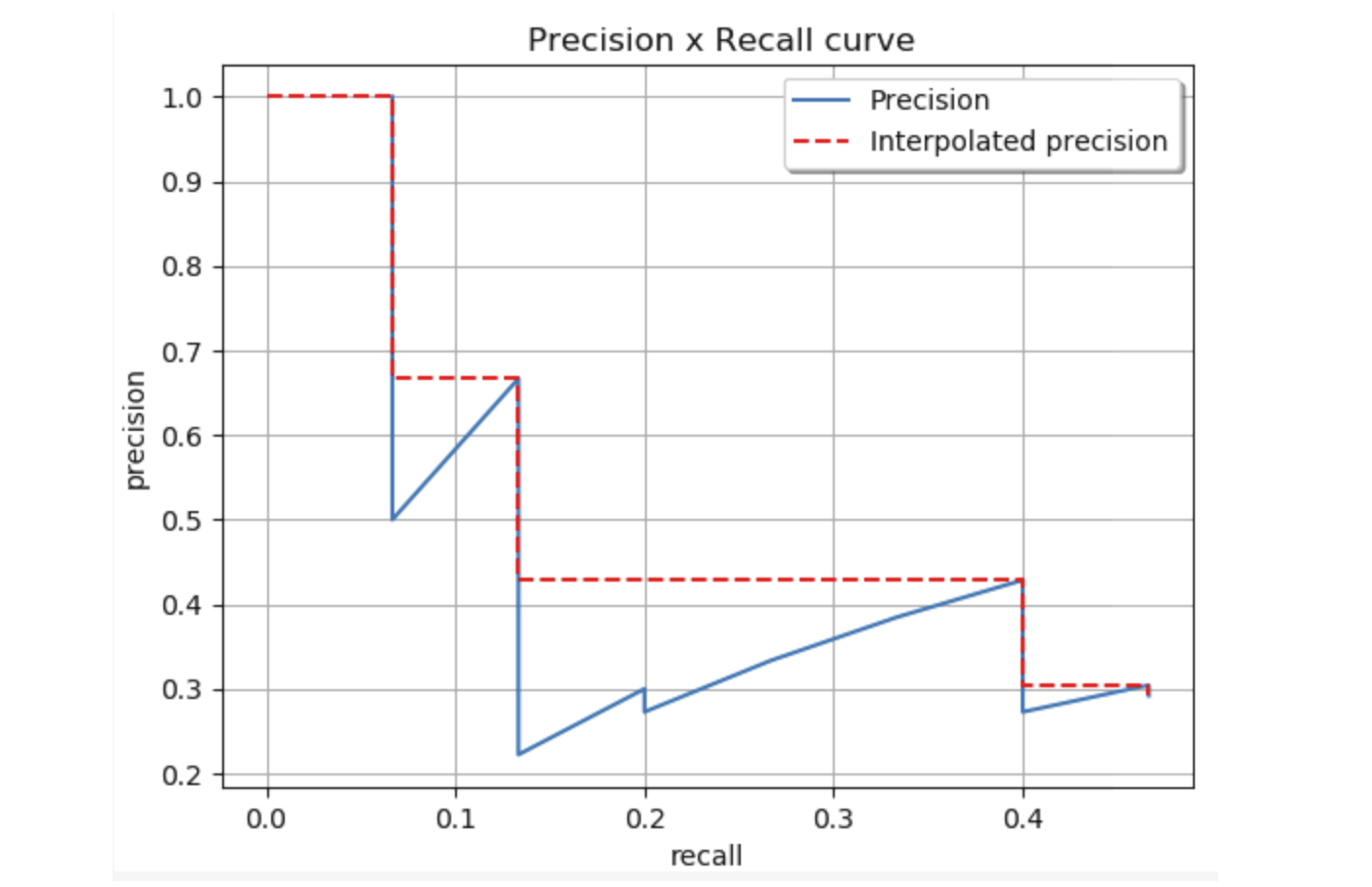🎉代码仓库地址:https://github.com/Oneflow-Inc/one-yolov5欢迎star one-yolov5项目 获取最新的动态。如果您有问题,欢迎在仓库给我们提出宝贵的意见。🌟🌟🌟如果对您有帮助,欢迎来给我Star呀😊~
指标评估(重要的一些定义)
📚 IOU
TP&FP&FN&TN
指标的一些基本概念:
- TP(True Postives):分类器把正例正确的分类-预测为正例。(IOU >= 阈值)
- FN(False Negatives):分类器把正例错误的分类-预测为负例。(IOU < 阈值)
- FP(False Postives):分类器把负例错误的分类-预测为正例
- TN(True Negatives):分类器把负例正确的分类-预测为负例(yolov5中没有应用到)
yolov5中没有应用TN的原因: TN代表的是所有可能的未正确检测到的边界框。然而在yolo在目标检测任务中,每个网格会生成很多的预测边界框,有许多的预测边界框是没有相应的真实标签框,导致未正确检测到的边界框数量远远大于正确检测到的边界框,这就是为什么不使用TN的原因。
threshold: depending on the metric, it is usually set to 50%, 75% or 95%.
Precision
Precision 定义:模型识别相关目标的能力。分类正确的样本在所有样本中的数量比例,公式如下:
Recall
Recall 定义:是模型找到真实回归框(_即标签标注的框_)的能力。计算公式如下:
mAP
多标签图像分类任务中图片的标签不止一个,因此评价不能用普通单标签图像分类的标准,即mean accuracy,该任务采用的是和信息检索中类似的方法—mAP,虽然其字面意思和mean average precision看起来差不多,但是计算方法要繁琐得多,mAP 会统计所有 Confidence 值下的 PR值,而实际使用时,会设定一个 Confidence 阈值,低于该阈值的目标会被丢弃,这部分目标在统计 mAP 时也会有一定的贡献。
Confidence(置信度):在统计学中,一个概率样本的置信区间(Confidence interval)是对这个样本的某个总体参数的区间估计。置信区间展现的是这个参数的真实值有一定概率落在测量结果的周围的程度。置信区间给出的是被测量参数测量值的可信程度范围,即前面所要求的“一定概率”。这个概率也被称为置信水平。
(红色曲线代表,人为的方式将PR曲线变成单调递减,使得计算面积更容易。)
目标检测中的mAP计算
yolov5计算IOU源码解析
源代码地址:
https://github.com/Oneflow-Inc/one-yolov5/blob/main/utils/metrics.py#L224-L261
# 计算两框的特定iou (DIou, DIou, CIou)
def bbox_iou(box1, box2, xywh=True, GIoU=False, DIoU=False, CIoU=False, eps=1e-7):
# Returns Intersection over Union (IoU) of box1(1,4) to box2(n,4)
# Get the coordinates of bounding boxes 下面条件语句作用是:进行坐标转换从而获取yolo格式边界框的坐标
if xywh: # transform from xywh to xyxy
(x1, y1, w1, h1), (x2, y2, w2, h2) = box1.chunk(4, 1), box2.chunk(4, 1)
w1_, h1_, w2_, h2_ = w1 / 2, h1 / 2, w2 / 2, h2 / 2
b1_x1, b1_x2, b1_y1, b1_y2 = x1 - w1_, x1 + w1_, y1 - h1_, y1 + h1_
b2_x1, b2_x2, b2_y1, b2_y2 = x2 - w2_, x2 + w2_, y2 - h2_, y2 + h2_
else: # x1, y1, x2, y2 = box1
b1_x1, b1_y1, b1_x2, b1_y2 = box1.chunk(4, 1)
b2_x1, b2_y1, b2_x2, b2_y2 = box2.chunk(4, 1)
w1, h1 = b1_x2 - b1_x1, b1_y2 - b1_y1
w2, h2 = b2_x2 - b2_x1, b2_y2 - b2_y1
# Intersection area 获取两个框相交的面积。
"""
left_line = max(b1_x1, b2_x1)
reft_line = min(b1_x2, b2_x2)
top_line = max(b1_y1, b2_y1)
bottom_line = min(b1_y2, b2_y2)
intersect = (reight_line - left_line) * (bottom_line - top_line)
"""
inter = (flow.min(b1_x2, b2_x2) - flow.max(b1_x1, b2_x1)).clamp(0) * \
(flow.min(b1_y2, b2_y2) - flow.max(b1_y1, b2_y1)).clamp(0)
# Union Area 两个框并到面积
union = w1 * h1 + w2 * h2 - inter + eps
# IoU
iou = inter / union
if CIoU or DIoU or GIoU:
cw = flow.max(b1_x2, b2_x2) - flow.min(b1_x1, b2_x1) # convex (smallest enclosing box) width
ch = flow.max(b1_y2, b2_y2) - flow.min(b1_y1, b2_y1) # convex height
if CIoU or DIoU: # Distance or Complete IoU https://arxiv.org/abs/1911.08287v1
c2 = cw ** 2 + ch ** 2 + eps # convex diagonal squared
rho2 = ((b2_x1 + b2_x2 - b1_x1 - b1_x2) ** 2 + (b2_y1 + b2_y2 - b1_y1 - b1_y2) ** 2) / 4 # center dist ** 2
if CIoU: # https://github.com/Zzh-tju/DIoU-SSD-pyflow.blob/master/utils/box/box_utils.py#L47
v = (4 / math.pi ** 2) * flow.pow(flow.atan(w2 / (h2 + eps)) - flow.atan(w1 / (h1 + eps)), 2)
with flow.no_grad():
alpha = v / (v - iou + (1 + eps))
return iou - (rho2 / c2 + v * alpha) # CIoU
return iou - rho2 / c2 # DIoU
c_area = cw * ch + eps # convex area
return iou - (c_area - union) / c_area # GIoU https://arxiv.org/pdf/1902.09630.pdf
return iou # IoUyolov5计算AP源码逐行解析
源代码地址:
https://github.com/Oneflow-Inc/one-yolov5/blob/main/utils/metrics.py#L96-L121
# 根据PR曲线计算AP
def compute_ap(recall, precision):
""" Compute the average precision, given the recall and precision curves
# Arguments
recall: The recall curve (list)
precision: The precision curve (list)
# Returns
Average precision, precision curve, recall curve
"""
# Append sentinel values to beginning and end 将开区间给补上,补成闭合的区间。
mrec = np.concatenate(([0.0], recall, [1.0]))
mpre = np.concatenate(([1.0], precision, [0.0]))
# Compute the precision envelope
"""
人为的把PR曲线变成单调递减的,例如:
np.maximum(accumulate(np.array([21, 23, 18, 19, 20, 13, 12, 11]) ) => np.array([23, 23, 20, 20, 20, 13, 12, 11])
"""
mpre = np.flip(np.maximum.accumulate(np.flip(mpre)))
# Integrate area under curve
method = 'interp' # methods: 'continuous', 'interp'
if method == 'interp': # 默认采用 interpolated-precision 曲线,
x = np.linspace(0, 1, 101) # 101-point interp (COCO)
ap = np.trapz(np.interp(x, mrec, mpre), x) # integrate
else: # 'continuous'
i = np.where(mrec[1:] != mrec[:-1])[0] # points where x axis (recall) changes
ap = np.sum((mrec[i + 1] - mrec[i]) * mpre[i + 1]) # area under curve
return ap, mpre, mrec参考文章
作者:Fengwen,BBuf
文章来源:GiantPandaCV
推荐阅读
- 阿里妈妈high_service:打造多媒体AI推理的极致性能!
- AMD Composable Kernel 大幅提升端到端Transformer性能
- 谈谈AI编译软件栈、软硬件协同、TVM和MLIR的看法
更多嵌入式AI干货请关注 嵌入式AI 专栏。欢迎添加极术小姐姐微信(id:aijishu20)加入技术交流群,请备注研究方向。








